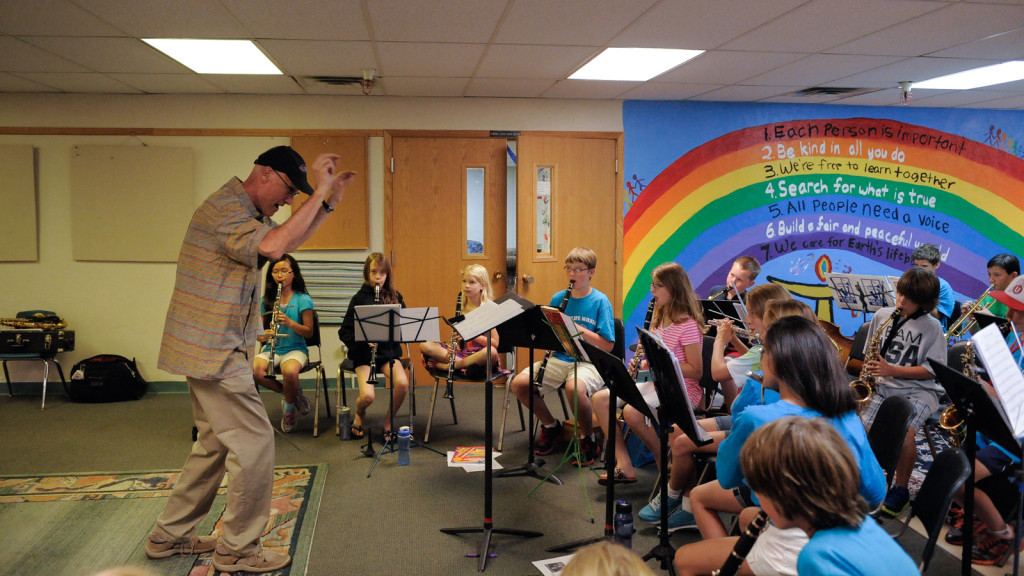Soundpainting is a Multi-Disciplinary Live Composing Sign Language, created by Walter Thompson. Mark Harris was certified as a soundpainter by Walter Thompson in January, 2013, and is available for workshops and demonstrations.
A living gestural language, currently having over 1200 gestures used by professionals, educators, students and lay people in at least 40 countries, soundpaintingis a collaborative means of creating music in the moment that is joyful, engaging and non-intimidating. It offers tremendous opportunity to educators desiring to involve more group creativity and improvisation in their programs. It is not style specific (though it can be used with styles), it is universally accessible, and a great deal of fun. It can be used with any sized group with any type of instrumentation, and with players of any combination of skill and experience level. Since it is a language, not a method, it is infinitely flexible, and can be suited to the needs of any group or program.
Soundpainting establishes a non-judgmental environment for students (and teachers) where they can explore sound, sound combinations, and take musical risks in a very uninhibiting environment. Soundpainting exercises player’s musicality, technique, memory, imagination, and ensemble skills, and the results can be as simple or complex as the players and soundpainters desire. As the players are essentially co-creators of the music, they are asked to make many musical decisions for themselves. As a result soundpainting is very effective at helping develop player’s aesthetics – asking ‘What is music?’ and ‘What is musical?’, ‘What is most musically appropriate?’ and ‘How can I improve what is going on?’. Used in combination with some dialogue with students, and questions about music, many aspects of music can be understood, explored, and experienced first hand in a spontaneous fashion. Elements such as tone, articulation, accompaniment, pitch, rhythm, melody, solos, harmony, dynamics, and much more can be isolated, or combined so students can use those elements as basic material in their soundpaintings, and create music while they come to a better understanding of how those elements are used in music, generally.
Mark Harris has done soundpainting workshops for Denver Public Music Ensemble directors, and soundpainted with the Denver Citywide Elementary school band in 2013, as well as with area school bands, orchestras, and choirs. He currently uses soundpainting (and other approaches) in his improvisation class at MSU Denver, and has soundpainted pieces with the MSU Denver Jazz Ensemble on concerts. Fun!
Soundpainting, Improvisation to the Brain Lecture, October 2013
Features and Benefits of Soundpainting
• Soundpainting is multidisciplinary- can be used with musicians, dancers, actors and visual artists simultaneously – can involve movement, or prose or visual arts.
• Encourages discovery of the potential of players’ instruments/voices
• Basic gestures can be learned quickly and easily
• Demands that players listen to each other, and create within their own limits
• Demands focus, attention and engagement from all involved
• Can be used with or without written music, thus frees players to try different physical setups on stage and in performance
• Allows students to direct/soundpaint/compose in real time, without having to notate
• Goes beyond just performance, and encourages discovery of music
• Palettes allow for use of predetermined music, or material
• Can involve movement – not necessarily dance
• Much less ‘right’ and ‘wrong’ as opposed to many approaches to improvisation (i.e. jazz)
• It is not harmony based, so less reliant on theory understanding, (though theory/harmony can certainly be a part or focus, if desired)
• Demands interaction (won’t work without it)
• Uses a variety of ways of interacting
• Allows and encourages development and exploration of extended techniques
• Directors are discoverers and explorers in music like their students
• Creates opportunity for improvising in a group setting – much less intimidating
• Creates non-judgmental environment in which to explore music
• Reinforces many ensemble concerns of notated music – ensemble feel, balance, blend, time, intonation, tempo, rhythm, etc.
• Offers sound combinations and possibilities not available with traditional notation
• Soundpainting allows us to be surprised in the course of creating then asks us to develop further
• Soundpainting is fully collaborative – players and soundpainters co-create the music in the moment
• Can be used with any type of non pitched or traditionally tonal instruments, (or homemade instruments!)
• Can be used for warmups, or as featured piece, or as method to work on specific musical skills, or as fun break in the middle of rehearsal
